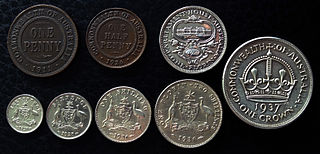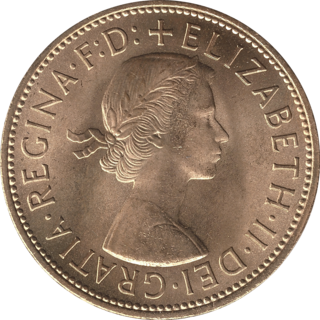
The standard circulating coinage of the United Kingdom, British Crown Dependencies and British Overseas Territories is denominated in pounds sterling, and ranges in value from one penny to two pounds. Since decimalisation, on 15 February 1971, the pound has been divided into 100 (new) pence. Before decimalisation, twelve pence made a shilling, and twenty shillings made a pound. British coins are minted by the Royal Mint in Llantrisant, Wales. The Royal Mint also commissions the coins' designs.

The shilling is a historical coin, and the name of a unit of modern currencies formerly used in the United Kingdom, Ireland, Australia, New Zealand and other British Commonwealth countries.

The British florin, or two-shilling coin, was issued from 1849 until 1967, with a final issue for collectors dated 1970. Equivalent in value to one-tenth of a pound, it was the last coin circulating immediately prior to decimalisation to be demonetised, in 1993, having for a quarter of a century circulated alongside the ten-pence piece, identical in specifications and value.

The British farthing coin, from Old English fēorðing, from fēorða, a fourth, was a unit of currency of one quarter of a penny, equivalent to 1/960 of a pound sterling, or 1/48 of a shilling. It was minted in copper and later in bronze, and replaced the earlier English farthings.

The British crown, the successor to the English crown and the Scottish dollar, came into being with the union of the kingdoms of England and Scotland in 1707. As with the English coin, its value was five shillings.

The sovereign is a gold coin of the United Kingdom that has a nominal value of one pound sterling. Struck since 1817, it was originally a circulating coin that was accepted in Britain and elsewhere in the world; it is now a bullion coin and is sometimes mounted in jewellery. In addition, circulation strikes and proof examples are often collected for their numismatic value. In most recent years, it has borne the design of Saint George and the Dragon on the reverse; the initials of the designer, Benedetto Pistrucci, are visible to the right of the date.

The pound sterling, known in some contexts simply as the pound or sterling, is the official currency of the United Kingdom, Jersey, Guernsey, the Isle of Man, Gibraltar, South Georgia and the South Sandwich Islands, the British Antarctic Territory, and Tristan da Cunha. It is subdivided into 100 pence. The "pound sterling" is the oldest currency in continuous use. Some nations that do not use sterling also have currencies called the pound.
The mill is a unit of currency, used in several countries as one-thousandth of the main unit. In the United States, it is a notional unit equivalent to a thousandth of a United States dollar. In the United Kingdom, it was proposed during the decades of discussion on the decimalisation of the pound as a 1⁄1000 division of the pound sterling. Several other currencies used the mill, such as the Maltese lira.

The lira or pound was the currency of Malta from 1972 until 31 December 2007. One lira was divided into 100 cents, each of 10 mils. After 1986 the lira was abbreviated as Lm, although the original ₤M sign was often used locally. In English the currency was still frequently called the pound even after its official English language name was changed to lira.

The Cypriot pound, also known as the Cypriot lira, was the currency of Cyprus, including the Sovereign Base Areas in Akrotiri and Dhekelia, from 1879 to 2007, when the Republic of Cyprus adopted the euro. However, the self-proclaimed Turkish Republic of Northern Cyprus used and still uses on the official level the Turkish lira.
Australian coins refers to the coins which are or were in use as Australian currency. During the early days of the colonies that formed Australia, foreign as well as British currency was used, but in 1910, a decade after federation, Australian coins were introduced. Australia used pounds, shillings and pence until 1966, when it adopted the decimal system with the Australian dollar divided into 100 cents. With the exception of the first Proclamation Coinage and the holey dollars, all Australian coins remain legal tender despite being withdrawn from circulation.

The dollar has been the currency of Barbados since 1935. The present dollar has the ISO 4217 code BBD, but the International vehicle registration code code BDS is also commonly used. The Barbadian dollar is divided into 100 cents.
The Manx pound is the currency of the Isle of Man, in parity with the pound sterling. The Manx pound is divided into 100 pence. Notes and coins, denominated in pounds and pence, are issued by the Isle of Man Government.
The coins of the South African rand are part of the physical form of South Africa's currency, the South African rand. In 1961, South Africa replaced the pound with a decimal currency: 100 cents (100c) = 1 rand (R1), 1 rand being valued at 10 shillings and 1 cent at 1.2 pence.
The coins of Canada are produced by the Royal Canadian Mint and denominated in Canadian dollars ($) and the subunit of dollars, cents (¢). An effigy of the reigning monarch always appears on the obverse of all coins. There are standard images which appear on the reverse, but there are also commemorative and numismatic issues with different images on the reverse.

The Coins of the Australian pound arose when the Federation of Australia gave the constitutional power to Commonwealth of Australia to mint its own coinage in 1901. The new power allowed the Commonwealth to issue legal tender rather than individually through the six former British self-governing colonies of Queensland, New South Wales, Victoria, Tasmania, South Australia, and Western Australia.
The Australian florin was a coin used in the Commonwealth of Australia before decimalisation in 1966. The florin was worth 24 pence . The denomination was first minted in 1910 to the same size and weight as the United Kingdom florin.

The Australian Shilling was a type of silver coinage issued by the Commonwealth of Australia, that circulated prior to the decimalisation of Australian coinage. The Australian shilling was derived from the British pre-decimal sterling pound system and was first issued following the passing of the Australian Coinage Act 1909, which established Australia's first formal currency system. The shilling was issued as part of Australia's silver coinage, which included the two-shilling (florin), the sixpence and the threepence. The shilling was minted from 1910 until 1963. During this period there was one significant modification to the design of the Australian shilling, the change in its reverse design, which occurred in 1938 when the design was altered from the Australian Coat of Arms (1910-1936) to the visage of a Merino ram’s head (1938-1963).

The pre-decimal penny (1d) was a coin worth 1⁄240 of a pound sterling, or 1⁄12 of a shilling. Its symbol was d, from the Roman denarius. It was a continuation of the earlier English penny, and in Scotland it had the same monetary value as one pre-1707 Scottish shilling. The penny was originally minted in silver, but from the late 18th century it was minted in copper, and then after 1860 in bronze.

Although the vast majority of coins are round, coins are made in a variety of other shapes, including squares, diamonds, hexagons, heptagons, octagons, decagons, and dodecagons. They have also been struck with scalloped (wavy) edges, and with holes in the middle. Coins in the shape of polygons often have rounded edges or are Reuleaux polygons.


















